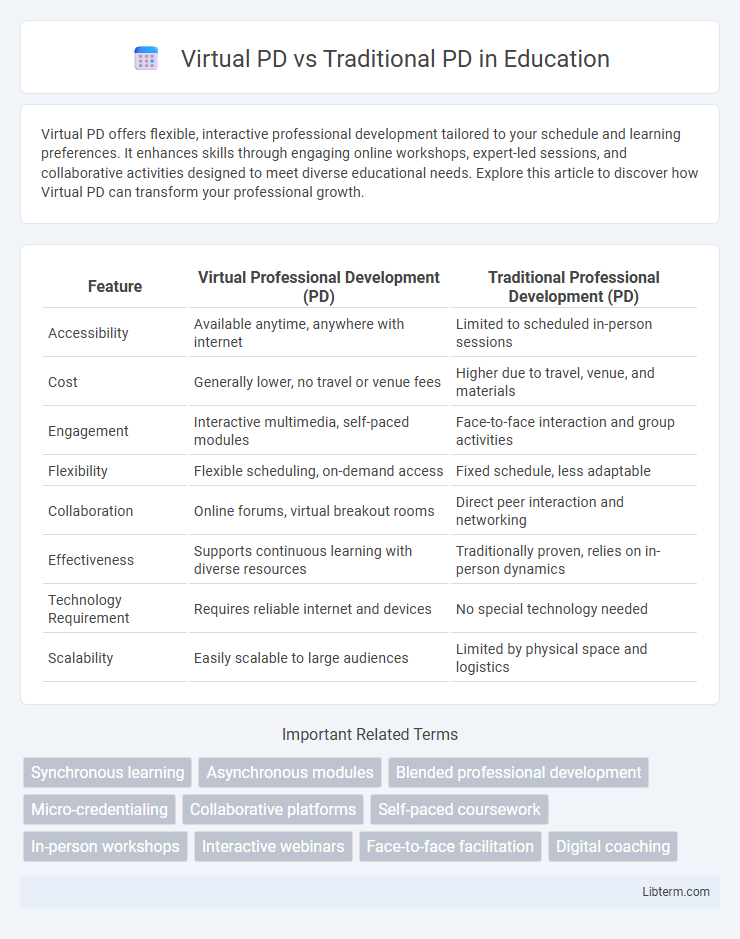Virtual PD offers flexible, interactive professional development tailored to your schedule and learning preferences. It enhances skills through engaging online workshops, expert-led sessions, and collaborative activities designed to meet diverse educational needs. Explore this article to discover how Virtual PD can transform your professional growth.
Table of Comparison
| Feature | Virtual Professional Development (PD) | Traditional Professional Development (PD) |
|---|---|---|
| Accessibility | Available anytime, anywhere with internet | Limited to scheduled in-person sessions |
| Cost | Generally lower, no travel or venue fees | Higher due to travel, venue, and materials |
| Engagement | Interactive multimedia, self-paced modules | Face-to-face interaction and group activities |
| Flexibility | Flexible scheduling, on-demand access | Fixed schedule, less adaptable |
| Collaboration | Online forums, virtual breakout rooms | Direct peer interaction and networking |
| Effectiveness | Supports continuous learning with diverse resources | Traditionally proven, relies on in-person dynamics |
| Technology Requirement | Requires reliable internet and devices | No special technology needed |
| Scalability | Easily scalable to large audiences | Limited by physical space and logistics |
Introduction to Professional Development (PD)
Virtual Professional Development (PD) offers flexible, technology-driven learning environments that enable educators to access tailored training anytime, anywhere, enhancing continuous skill improvement. Traditional PD typically involves in-person workshops or seminars, providing direct interaction but limited by scheduling and geographic constraints. Emphasizing engagement, resource accessibility, and personalized growth, virtual PD platforms increasingly complement and sometimes replace traditional methods to meet diverse professional learning needs.
Defining Virtual PD and Traditional PD
Virtual Professional Development (PD) refers to online or digital learning experiences designed to enhance educators' skills using web-based platforms, interactive webinars, and virtual workshops, enabling flexible and self-paced participation. Traditional PD involves in-person training sessions, face-to-face workshops, and physical seminars where educators engage in direct interaction and hands-on activities within a structured time frame. Both approaches aim to improve teaching effectiveness but differ in delivery methods, accessibility, and engagement formats.
Key Features of Virtual PD
Virtual Professional Development (PD) offers flexible access to training materials and sessions anytime, enabling educators to learn at their own pace without geographic constraints. It incorporates interactive multimedia content, real-time feedback, and collaborative tools such as discussion forums and virtual breakout rooms to enhance engagement. Data analytics track participant progress and tailor learning experiences, ensuring personalized growth and measurable outcomes compared to the one-size-fits-all approach in traditional PD.
Key Features of Traditional PD
Traditional professional development (PD) emphasizes face-to-face interaction, hands-on workshops, and collaborative group activities to foster skill-building and peer learning. It often involves scheduled sessions with direct mentorship, immediate feedback, and networking opportunities that enhance engagement and retention. Key features include structured agendas, in-person facilitation, and a strong emphasis on real-time discussion and practice within physical learning environments.
Accessibility and Flexibility Comparison
Virtual professional development (PD) offers unparalleled accessibility, enabling educators to participate from any location with internet access, overcoming geographical and time constraints inherent in traditional PD sessions. Flexibility in virtual PD allows for asynchronous learning options, permitting educators to engage with materials and complete training at their own pace, contrasting with the fixed schedules of in-person PD. This accessibility and flexibility significantly enhance participation rates and accommodate diverse learning styles, making virtual PD a more inclusive and adaptable option for professional growth.
Cost and Resource Efficiency
Virtual professional development (PD) significantly reduces costs by eliminating travel, accommodation, and venue expenses associated with traditional PD. Resource efficiency improves as digital platforms enable scalable delivery, allowing more educators to participate simultaneously without increasing facilitation resources. The asynchronous nature of many virtual PD sessions also maximizes flexibility, reducing time away from classroom responsibilities and increasing overall productivity.
Participant Engagement and Interaction
Virtual PD platforms incorporate interactive tools such as polls, breakout rooms, and chat features that boost participant engagement by enabling real-time collaboration and instant feedback. Traditional PD often relies on face-to-face interaction, which naturally fosters networking and spontaneous discussions but may limit active participation due to time constraints or participant reticence. Research shows virtual PD can increase engagement through flexible, multimedia content delivery while traditional PD benefits from physical presence, enhancing social cues and deeper interpersonal connections.
Effectiveness and Learning Outcomes
Virtual professional development (PD) leverages digital platforms to offer flexible, interactive learning experiences that often enhance engagement and retention compared to traditional PD methods. Studies indicate that virtual PD can improve learning outcomes by providing personalized content, real-time feedback, and opportunities for collaboration beyond geographical limits. Traditional PD, while valuable for hands-on practice and face-to-face interaction, may lack the scalability and accessibility that virtual PD delivers, potentially limiting overall effectiveness in meeting diverse learner needs.
Challenges and Limitations
Virtual professional development (PD) often faces challenges such as limited participant engagement, technology access issues, and reduced opportunities for hands-on practice compared to traditional PD. Traditional PD allows for richer face-to-face interaction, immediate feedback, and collaborative learning environments, which are harder to replicate in virtual settings. Both formats encounter limitations, but virtual PD demands robust digital infrastructure and self-motivation to overcome barriers related to connectivity and distractions.
Future Trends in Professional Development
Virtual professional development (PD) is increasingly leveraging AI-driven personalized learning paths and immersive technologies such as virtual reality to enhance skill acquisition and engagement. Traditional PD methods are evolving to integrate hybrid models, combining face-to-face interactions with digital platforms to accommodate diverse learner preferences. Data analytics and real-time feedback systems are expected to drive more adaptive, scalable, and accessible professional development experiences in the near future.
Virtual PD Infographic

 libterm.com
libterm.com